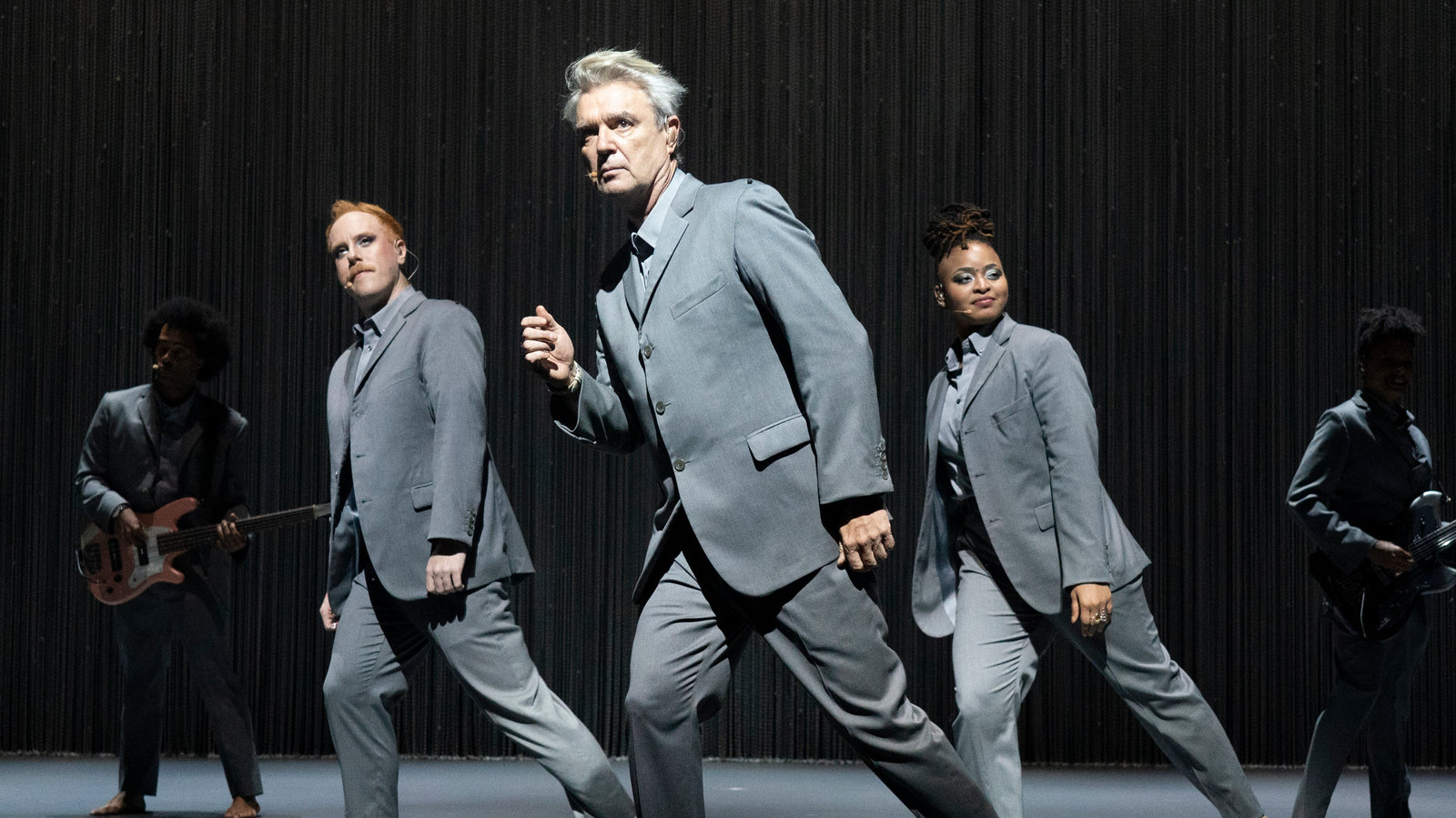“Introducing the all new 2020 David Byrne human being! A timeless classic is back in style, now sleeker and more accessible than ever before. The Byrne returns with its classic mobility, quirky observations, pretentious cultural knowledge and signature yodel. The latest model also comes complete with friendly human interactions, heartwarming optimism and a nostalgia-friendly supply of Talking Heads songs. Safe, synchronized and comfortable, everybody deserves a Byrne in their homes. Now available at your local Walmart!”
It’s hard to watch the art rock icon awkwardly dance to his band’s lock-step rhythms and not think they’re all moving on mechanical gears. At 68-years-old and over 40 years in the performing arts, David Byrne has reinvented himself as many times as the color TV or the four-door sedan. He’s sported so many different sounds, words and colors that all he has left to do is be as basic as he can: a plain grey suit, a plain grey stage, musicians casually popping in-and-out of songs with little to no flare. All Byrne has left is basic human hope and for him (and the rest of the world), that might be enough.
There’s no need to compare Stop Making Sense, Jonathan Demme’s 1984 performance documentary with another famous bland suit, to David Byrne’s American Utopia, the latest performance captured at the Hudson Theatre on Broadway by Spike Lee earlier this year. Despite playing similar songs and being backed by another astoundingly-tight band, Byrne’s vision has clearly expanded since Talking Heads called it quits. It’s fitting that Byrne opens the show singing “Here” while mapping out parts of a brain, since American Utopia is basically a window into how his own developed over the years. His fascination with the endless visions of others spilling out from screens into his life comes to fruition when his bandmates creep closer to him while singing “I Should Watch TV.” He still has a fear of the unknown (whether it be people, places or things) as he plays out the nervous rhythms of “Everybody’s Coming to My House.” No matter how much synchronized nonsense like “I Zimbra” bounces in his head, he has no problem being as stilted and awkward as possible while jumping between the two tones of “I Dance like This.”
Photo Credit: HBO
Whatever paranoia, fear or nonsense is found in Byrne’s lyrics, you’d never get the sense of any negativity from his and his band’s delivery. There’s so much groove and buoyancy to “Slippery People,” “Lazy,” “Toe Jam” and “Burning Down the House” that the sweat marks seeping through the suits of the performers are well earned by the show’s end. It’s especially surprising to feel such a positive vibe in the Talking Heads songs Byrne performs. “Once in a Lifetime” in its original recording sounds like a yuppie bemused yet unphased by the blandness of American suburbia, but American Utopia shows Byrne reveling in acceptance of “same as it ever was.” Lyrically, “Don’t Worry About the Government” would be the thing Tyler Durden would mock anyone for, but Byrne’s performance is so sincere and quirky that it’s like he’s cheering on the bean counters of the world. “Road to Nowhere,” which closes the show, didn’t need any additional help being positive, but after Byrne talks about the importance of voting and the heart wrenching intercuts of unjustly killed Black people during “Hell You Talmbout,” it’s a much-needed reminder to look for change.
For all the looseness of the sound, the band stays in lock-step synchronization with each other. Lee and his editors do a serviceable job of cutting between beats of the band’s disassembled drum parts, though he has occasional moments of blocking trouble and awkward shots since his crew only has so much time to be onstage before becoming distractions. It’s still impressive to see the crisp close-ups Lee gets of Byrne and his expressive performers, even more so that he manages to use his classic dolly shot on a lamppost. It might be a touch distracting to see the silhouettes of the audience at times, but it’s likely that Byrne insisted on having the human connection this time around. American Utopia is certainly one of the oddest movies in Lee’s filmography because he has no control in the style at all, making his presence behind the camera near-anonymous. But even when following the lead of another tastemaker, Lee is still damn good at filmmaking.
While its setting is isolated and its creator remains incredibly singular, David Byrne’s American Utopia is open for everyone. Not only does it revitalize old songs in Byrne’s catalogue, but adds more detail to the album the show shares its name with. Before going into “One Fine Day,” Byrne goes back to the brain and notes how it’s always developing. He talks about the connections present in the brains of infants and how people lose those connections as they get older. For an artist that’s been going at his own pace for so many years, it’s refreshing to see him reaching out to others for a bond rather than letting others try catching up to him.
Advertisement
Advertisement
